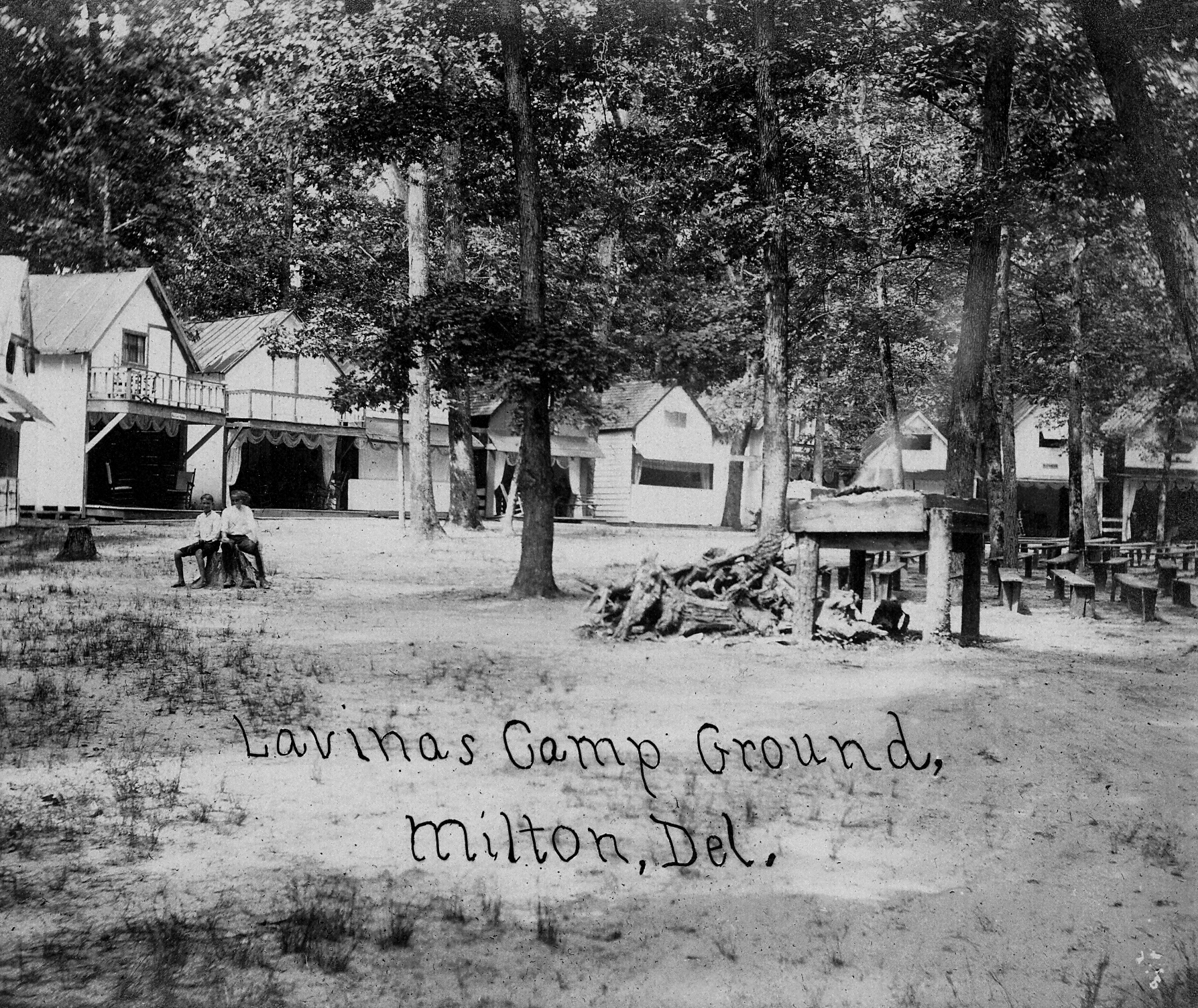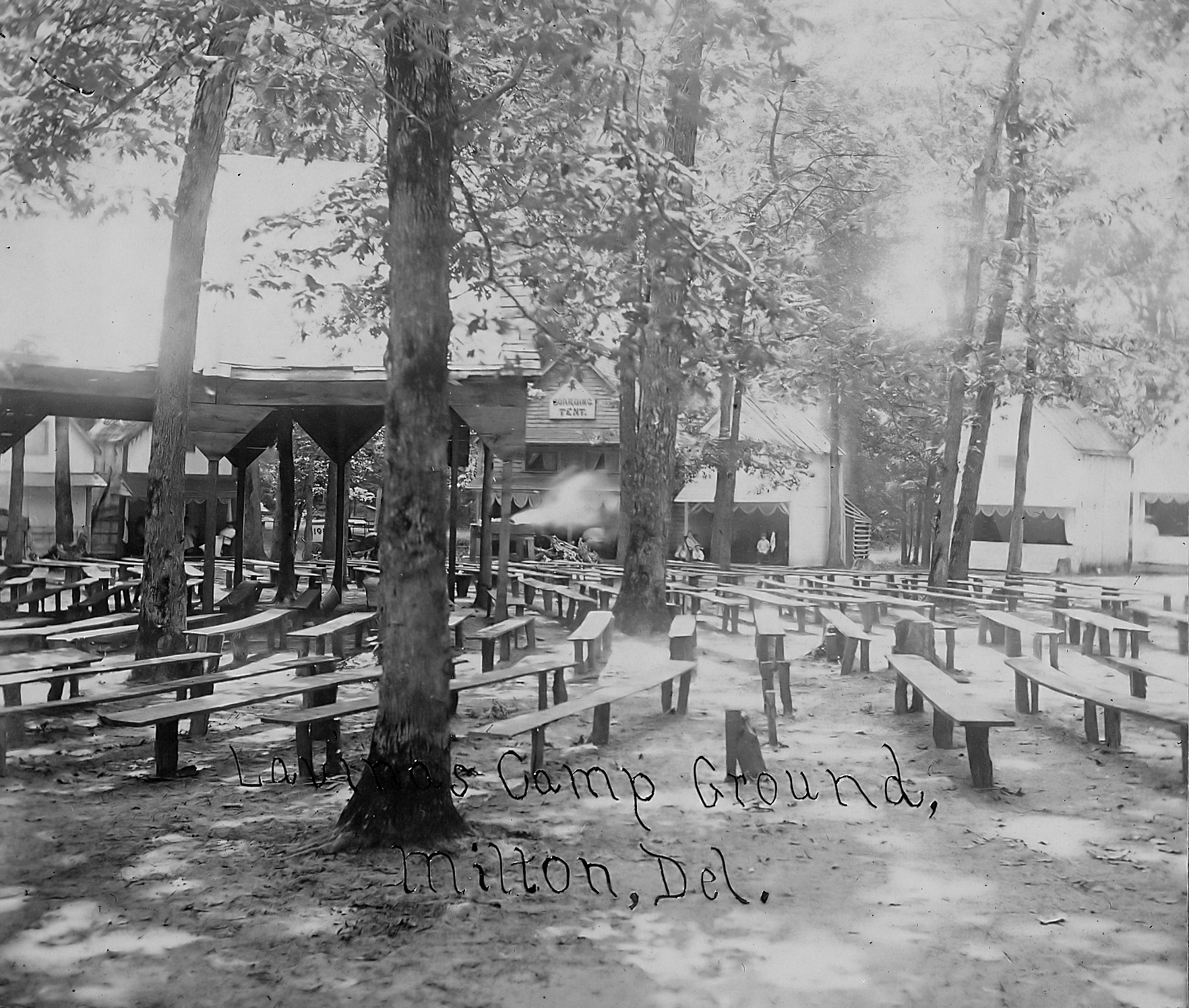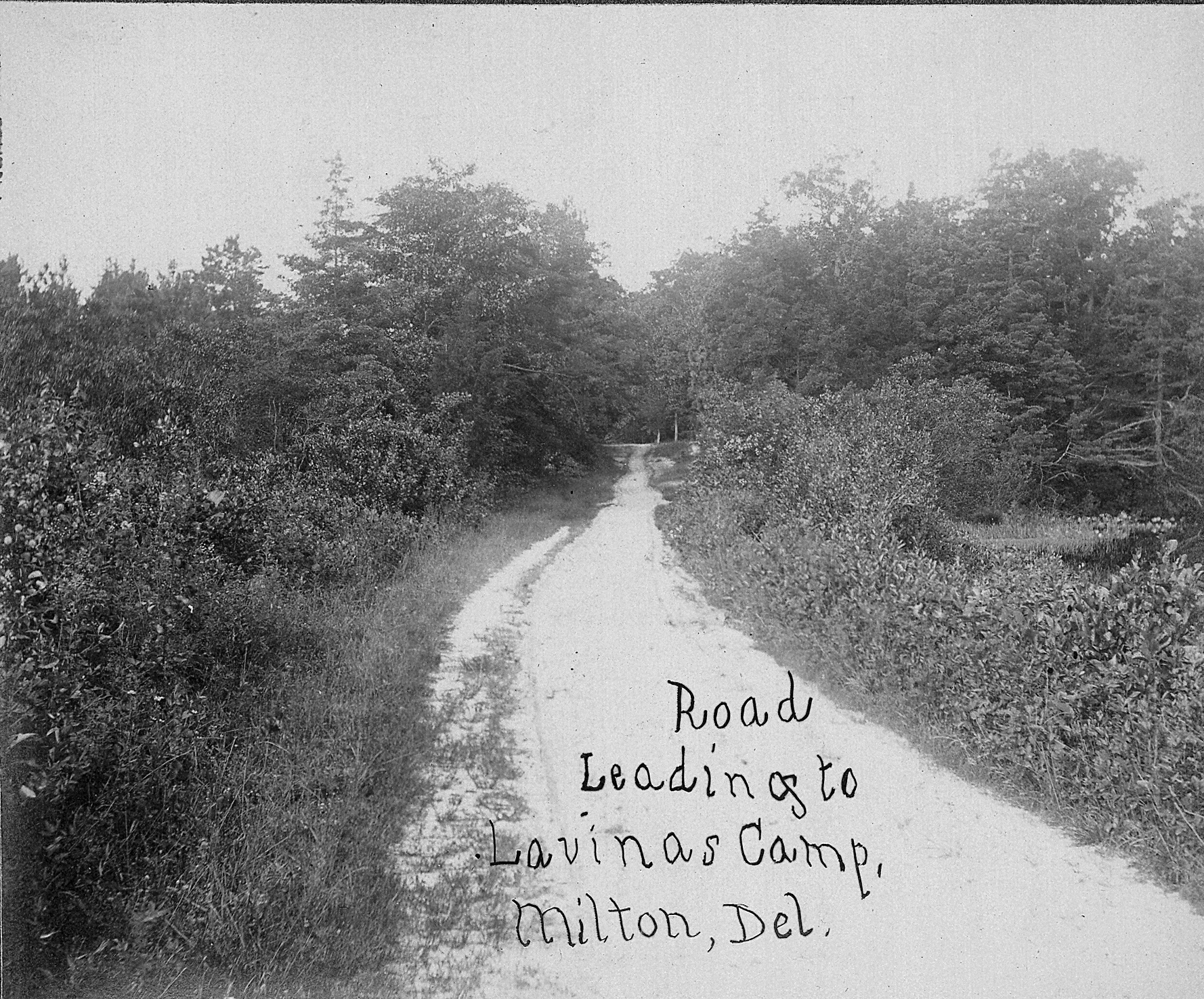This
post is about the history of the Milton Camp, sometimes called
Lavinia's Camp Ground, Lavinia's Grove camp, or Lavinia's Wood camp.
Because of the camp's long history and many areas of interest, I am
dividing the article into two segments. Part I will look at the history
of the camp and the social drivers behind it, and Part II will present
some first-hand accounts of camp meetings.
With
a few interruptions, the Milton camp meeting - an outdoor "tent
revival" in August that ran a week or more in Lavinia's Woods - lasted
at least until 1965. There is nothing I can find in the Delaware
newspapers after 1965 to indicate either that the camp meeting continued
to take place, or when it was abandoned. There were actually two camp
meetings every year at Lavinia's Woods - one attended by African
Americans under the auspices of the local A. M. E. congregation, and one
by the Milton Methodist Protestant Church attended by whites. The color
line was not a solid barrier, as some members of both races attended
each other's camp meetings from time to time. However, for lack of
sufficient resources at my disposal, this post is limited to the white
people's camp meeting.
Before
I delve into what is known about the camp meetings, some historical
background is necessary to explain this enduring feature of American
Protestant religious life.
The Great Awakenings
In
the context of religion, the term "Awakening" refers to the end of a
long slumber of secularism and religious indifference. Theological
historians have defined three periods in the 18th and 19th centuries
when evangelism acquired renewed momentum and many new converts were
brought into the Methodist and Baptist traditions. The First Great Awakening
began in England in the 1730's and lasted until 1743 after being
exported to the American colonies. This first revival was powered by a
new style of sermonizing that eschewed the dense theological
investigative sermons that ministers read to the congregation, in favor
of a style of communication, often extemporaneous, that sought to
spiritually energize the audience and attract converts.
The Second Great Awakening
began in the United States in the late 18th century and reached its
peak in the middle of the 19th. The so-called "fire and brimstone" style
of preaching is one example of a new type of theological rhetoric that
was not directed at the intellectual elites of society, but rather to
the common, less-educated population. It was evidently quite successful.
One area of western New York State (bordered by Lakes Erie and Ontario
to the north and west, and including much of the Finger Lakes region)
was dubbed the "burned-over district" because the sheer number of
converts there meant no more "fuel" (potential new converts) to "burn"
(convert). The temperance, women's suffrage, and abolitionist movements
of the 19th century had deep roots in the reformist spirit that was part
of the religious fervor of the "burned-over district." The area also
spawned Mormonism and several utopian movements.
Western
New York State was an underpopulated frontier area in the early 19th
century, as were Kentucky, Ohio, and Tennessee. It is in this period
that camp meetings led by preachers of various Protestant denominations
began to spring up. Presbyterian minister James McGready is generally
thought by historians to have originated the first camp meeting in the
U. S., in Kentucky, in 1799 - 1801. These camp meetings were described
as highly emotional, and participants were susceptible to states of high
excitement, rapture, "convulsions," speaking in tongues, and the like.
Attendees literally camped at the meeting, as there were no hotel
accommodations to be had in frontier areas.
The
sustained excitement stoked by preacher after preacher for hours and
days on end, and the congregation of thousands of normally isolated
people at these first camp meetings bred all kinds of non-spiritual
excesses, including drinking, gambling, and (according to at least one
observer) sexual promiscuity and abandon. A common joke at the time
maintained that frontier populations spiked about nine months after a
camp meeting, and the newborns were called "camp meeting babies." There
is no way to verify the truth of this assertion, facetious or not.
By
the 1850's, camp meeting organizers maintained increased vigilance over
attendees' behavior and the excesses of the earlier years were kept
under better control. By the time of the Third Great Awakening
in the latter half of the 19th century, Methodist churches in the
mid-Atlantic region, including Delaware, operated perennial camp
meetings in the summer months in many locations; evangelism advanced on
multiple fronts, including missionary work, permanent religious retreats
at Rehoboth, DE and Ocean Grove, NJ, and the Y. M. C. A.
The Milton Camp Meeting (Lavinia's Camp Ground)
The
Milton Camp Meeting at Lavinia's Camp Ground just outside of town, to
the best of my knowledge, has its origins in the Third Great Awakening.
The earliest newspaper reference to it can be found in the September 6,
1873 issue of the Wilmington News Journal, but I believe this
camp meeting, run by the Milton Methodist Protestant Church, would have
begun some years before that. A report in the August 3, 1914 issue of
the Wilmington Morning Journal asserted that Lavinia's Camp was
about sixty-six years old, which would bring its initial year to 1848,
several years before the establishment of the Milton M. P. congregation
in 1857. Yet another newspaper article suggests that the camp may have
been started by the Methodist Episcopal Church as early as 1835.

Lavina's Camp Ground, ca. 1911, photographed by Dr. William H. Douglas (Milton Historical Society collection)
The
photograph above, found in the Douglas Family folder, is one of only
two known photographs of the Milton Camp Meeting. In the background are
the "tents," which were actually small cottages owned or rented by
families attending the camp meeting. They are two stories tall,
presumably with the bedroom(s) in the upper floor and an open sitting
area on the ground floor. Some have ornamentation (the balconies and
railings in the two leftmost cottages). These cottages were arranged in a
circle around the tabernacle, which is not visible in the photograph
but would have been just beyond the benches in the right side of the
photograph. The benches themselves are arrayed in a semi-circle in front
of the tabernacle.
The
table-like structure in the right foreground with the wood pile next to
it was the source of light for nighttime activities: four logs with a
dirt-filled slab on top of them. A bonfire was built and lit at dusk on
top of the dirt.

Milton Camp Meeting, ca. 1911 photographed by Dr. William H. Douglas (Milton Historical Society collection)
The
photograph above, taken by the same photographer, appears to have been
taken on the opposite side of the camp pictured in the first photograph.
The evening fire on the raised dirt slab is smoldering at center
background. That and the low position of the sun through the trees
suggest that the photograph was taken in the morning. Some boys are
standing under the awning, to the right of the fire platform; an
automobile or truck is partially visible in the far background, to the
left of the smoke. The benches facing the tabernacle, at left, are
spartan; they have no backs and are just plain wood. Another interesting
feature is the "boarding tent" in the center background. Meals were
prepared, sold and served in the boarding tent, which was also a
permanent structure rather than canvas. The boarding tent as well as
several other services provided in the camp were operated by individuals
as "privileges" (concessions) that the Milton M. P. Church auctioned
off to the highest bidder. The following excerpt from the Milton News
letter in the Milford Chronicle of July 11, 1902 provides some insight
into the issues surrounding concessions at the camp meeting:
At
the sale of the privileges held on Saturday, the boarding tent brought
$1; the food pound $9; these were purchased by Prof. W. H. Welch. The
confectionery department was bought by John Barker for $5. One of the
officers of the church requests the writer to say that the small prices
these privileges were sold for was due to the action of the church,
which will not allow anything to be sold on Sunday; and the two Sundays
that include a part of the camp are the best days the proprietors of
these privileges can have. This may be all right from a moral
standpoint; but as these meetings are held more for sociality than for
spiritual comfort, you had better get all out of them that you can.
At
the sale of the privileges for the colored camp at Hazard’s Woods, near
the end of Milton Lane, the confectionery stand brought $36; and the
boarding tent $12. Witness the contrast, when viewed from a financial
standpoint.
The
"food" pound Conner referred to may have been the horse pound or
stabling area, as this was the age of the horse and buggy. Selling food
or confectionery at these camp meetings would not make anyone rich.
There was an additional problem: the Milton camp meeting was within easy
walking distance to the center of town, and attendees did not have to
rent a "tent" or buy food from the camp concessions if they chose not
to. Indeed, Milton town residents had always made up the bulk of the
attendance at the Milton Camp meeting, and could walk into or out of the
camp without difficulty.
There is also another statement in the first paragraph: ..these meetings are held more for sociality than for spiritual comfort.
By the early 20th century, the summer camp meeting was seen by many as a
social event, and there were few converts made. The value of the Milton
Camp meeting as an evangelical tool was called into question for years
by the M. P. church, but what led to the end of the church's involvement
with the camp meeting was something entirely different.

Road leading to Lavina's Woods camp, ca 1911 photographed by Dr. William H. Douglas (Milton Historical Society collection)
The End of the Milton Camp Meeting
In the July 22, 1918 issue, the Wilmington News Journal
reported several cases of what was first thought to be chickenpox in
one Georgetown family. The diagnosis changed to smallpox as the symptoms
became more severe, and a previously unreported outbreak of smallpox in
Gumboro came to light. Just two days later, the Wilmington Morning
Journal reported that camp meeting season was beginning to ramp up and a
full season was planned. But by July 30, organizers of several camp
meetings on the Peninsula, including the Milton Camp, were advised by
the State Board of Health not to hold planned meetings due to the fear
of contagion. The camp meeting did not take place that year, but the
decree to close it came after concessionaires and others had already
invested money in preparation.
In the August 4, 1919 issue of the Wilmington Morning News,
it was reported that the committee organizing that year's Milton Camp
meeting had decided not to hold it. The reasons given in that newspaper
were the lack of cooperation among members of the congregation and the
inability to find someone to manage the boarding tent. However, David A.
Conner, writing in his Milton News letter in the August 4, 1919 issue
of the Milford Chronicle, gave a somewhat different view of the
abandonment of the Milton camp meeting. He stated that it had for many
years been a social event rather than a spiritual one; before the advent
of the automobile and the railroad, the camp meeting was eagerly
anticipated by country people who were far from a church, were
relatively isolated, and needed a respite. Modern transportation had
provided all classes with the means to enjoy alternatives to the camp
meeting such as beach excursions, which were proving immensely popular.
A New Lease on Life
In
September of 1897, in Cincinnati, a group of Methodist Episcopalians
founded the International Holiness Union and Prayer League, which was
intended to be a fellowship and not a new denomination. By 1900,
however, the fellowship had acquired many adherents who were attracted
by its principles and its evangelic missionary work overseas. Its name
was changed to International Apostolic Holiness Union. By 1905, having
grown into a formal church organization in all but name, the group was
renamed to International Apostolic Holiness Union and Churches. After a
further period of growth and absorption of other religious bodies, the
overall organization adopted the name of one of the absorbed churches
and became the Pilgrim Holiness Church.
The
Pilgrim Holiness Church arrived in Milton in 1926, held their first
meeting on Easter Sunday of that year, and dedicated their church
building on April 11. This made a total of four Protestant churches
attended by whites of the town. In 1927, the newly established church
re-opened the Lavinia's Camp under their auspices. The camp continued in
operation until at least 1965.
Postscript
The
two Methodist branches, Episcopalian and Protestant, as the United
Methodist Church around 1940, with the result that the Milton Methodist
Protestant Church, or Grace Church as it had been renamed, became
superfluous to the administrative body of the UMC and disappeared by
1962. The former church building was restored in 2006 and is now the
home of the Milton Historical Society and the Lydia B. Cannon Museum.
On
June 26, 1968, The Pilgrim Holiness Church and The Wesleyan Methodist
Church of America were united to form The Wesleyan Church, which is
still a presence in the religious life of the Milton community.
Sources:
An Account of Lavina's Camp Meeting, anonymous typewritten manuscript (MHS Collection)
Wikipedia
Wilmington News Journal, September 6, 1873
Milton News letter, Milford Chronicle, July 11, 1902
Wilmington Morning Journal, August 3, 1914
Wilmington News Journal, July 22, 1918
Wilmington Morning News, August 4, 1919
Wilmington News Journal, July 3, 1959
Wilmington Morning News, July 10, 1965




No comments:
Post a Comment